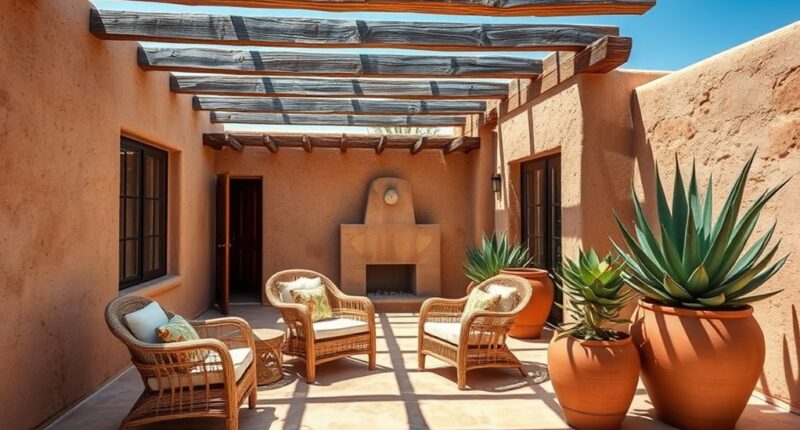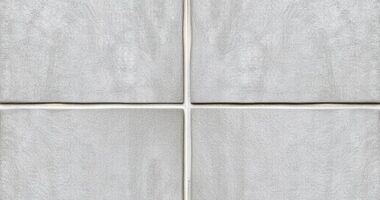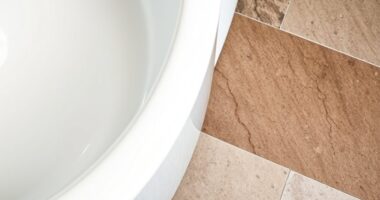For the Sonoran Climate, choose durable, UV-resistant materials like powder-coated aluminum or stainless steel for fixtures to prevent corrosion. Opt for natural or composite stone and textured concrete finishes that resist warping, fading, and dust accumulation, while offering high thermal mass to manage heat. Use reflective, light-colored surfaces on pathways to stay cooler underfoot. Fabrics must be UV-stabilized and fade-resistant, ensuring longevity and comfort. Continues to explore how specific materials combine resilience with aesthetic appeal.
Key Takeaways
- Use UV-resistant, fade-proof materials like powder-coated metals and solution-dyed fabrics to withstand intense sunlight.
- Incorporate high thermal mass surfaces such as stone or concrete to absorb and slowly release heat, reducing temperature fluctuations.
- Select durable, weather-resistant finishes and permeable pavers to prevent dust accumulation, resist dust, and manage water runoff.
- Choose corrosion-resistant alloys for outdoor fixtures and natural or composite woods resistant to warping and cracking.
- Opt for textured or reflective surface finishes to minimize glare, slip hazards, and heat buildup in outdoor spaces.

Living in the Sonoran Desert requires selecting outdoor materials that can withstand its extreme temperatures, intense sunlight, and arid conditions. These environmental factors demand materials with exceptional durability, low thermal conductivity, and resistance to UV degradation. When choosing surfaces and structural components, you must consider their ability to resist warping, fading, and cracking over time, ensuring longevity without frequent maintenance or replacement. Materials with high thermal mass, such as certain stone or concrete options, absorb and slowly release heat, helping to moderate temperature fluctuations and create a comfortable outdoor environment. Conversely, lightweight materials with reflective properties can deflect solar radiation, reducing heat absorption and enhancing comfort during peak sunlight hours.
Choose durable, UV-resistant materials with high thermal mass to thrive in the Sonoran Desert’s harsh climate.
The aesthetic appeal of materials should not be sacrificed for durability; instead, select options that harmonize with the desert’s rugged landscape while maintaining functionality. Textured finishes on stone or concrete can minimize glare and provide slip resistance, critical in hot, dry conditions where surfaces can become slick with dust or moisture. The surface treatment should also resist dust accumulation and be easy to clean, reducing the need for frequent upkeep in a landscape prone to wind-blown particles. For wood, choose species with natural resistance to UV damage and moisture, such as cedar or certain tropical hardwoods, or opt for composite alternatives that blend natural appearance with enhanced weather resistance.
Metal fixtures and furniture require corrosion-resistant alloys, like powder-coated aluminum or stainless steel, to withstand the aggressive UV and temperature extremes. These metals should be treated with protective finishes that prevent oxidation and maintain their structural integrity over years of exposure. For fabrics and outdoor textiles, UV-stabilized, fade-resistant materials like solution-dyed acrylics or polyester are essential. These fabrics should be tightly woven, with a high thread count, to resist tearing and provide effective shade while withstanding the relentless sun. Additionally, selecting corrosion-resistant alloys for outdoor fixtures is crucial to prevent deterioration caused by the harsh desert environment.
In addition, selecting permeable materials for pathways and patios helps manage water runoff and reduces heat buildup. Pavers with high thermal reflectance and low heat retention are preferable, as they remain cooler underfoot compared to darker or less reflective options. Overall, the ideal outdoor materials for the Sonoran environment combine technical resilience with aesthetic versatility, ensuring your outdoor space remains both functional and visually appealing despite the harsh desert conditions. Proper selection and treatment will extend the lifespan of your design, minimize maintenance, and enhance your outdoor living experience amid the desert’s formidable climate.
Frequently Asked Questions
How Do Outdoor Materials Perform During Extreme Heat Waves?
During extreme heat waves, outdoor materials like high-quality concrete, tile, and treated stone perform well by resisting cracking and thermal expansion. Breathable fabrics with reflective coatings help keep surfaces cooler and prevent heat absorption. You’ll find that choosing materials with high thermal inertia and low porosity reduces surface temperature fluctuations, ensuring durability and aesthetic appeal. Proper installation and protective finishes further enhance their resilience, maintaining both function and visual appeal under intense heat.
What Are the Best Eco-Friendly Outdoor Materials for Sonoran Landscapes?
You’ll want to choose eco-friendly materials like recycled concrete, permeable pavers, and native drought-tolerant plants that thrive under the Sonoran sun. These options minimize environmental impact, reduce water usage, and enhance landscape resilience. Think textured natural stone, sustainable mulches, and biodegradable composites that blend aesthetics with functionality. By prioritizing these materials, you create a sustainable outdoor space that resists climate extremes while supporting local ecosystems.
How Resistant Are These Materials to Desert Pests and Wildlife?
These eco-friendly outdoor materials exhibit high resistance to desert pests and wildlife, thanks to their dense, natural fibers and chemical treatments that deter insects and animals without harmful effects. You’ll find that materials like treated wood, composite composites, and certain durable fabrics withstand chewing, burrowing, and nesting behaviors. Regular maintenance enhances their resilience, ensuring longevity while maintaining an aesthetically pleasing landscape that naturally blends with the Sonoran environment.
Can These Materials Withstand Monsoon Flooding and Heavy Rains?
These materials stand strong like a fortress against monsoon flooding and heavy rains. They’re engineered with waterproof, UV-resistant coatings that repel water and prevent deterioration. Advanced sealants and drainage features ensure water doesn’t seep in or cause damage. Their durability is tested under extreme conditions, making them reliable in the Sonoran climate’s unpredictable storms. You can confidently rely on these materials to keep your outdoor spaces protected and vibrant even during heavy rains.
Are There Maintenance Tips for Prolonging Outdoor Material Durability?
You should regularly clean and inspect your outdoor materials, removing debris and dirt that can cause deterioration. Apply protective sealants or coatings suited for the material and climate, reapplying as recommended. Make certain proper drainage around structures to prevent water pooling, and trim nearby vegetation to reduce moisture contact. During the hottest months, periodically check for cracks or fading, and address minor damages promptly to prolong durability and maintain aesthetic appeal.
Conclusion
Choosing outdoor materials suited for the Sonoran climate isn’t just about durability—it’s about harmony with the environment. When you select heat-reflective tiles or drought-resistant plants, you inadvertently mirror the desert’s resilience, aligning function with beauty. The coincidence lies in how these materials, designed to withstand extreme temperatures, also enhance aesthetic appeal, creating a seamless blend of form and function. In this way, your outdoor space becomes a demonstration of thoughtful design rooted in the very essence of the Sonoran landscape.








